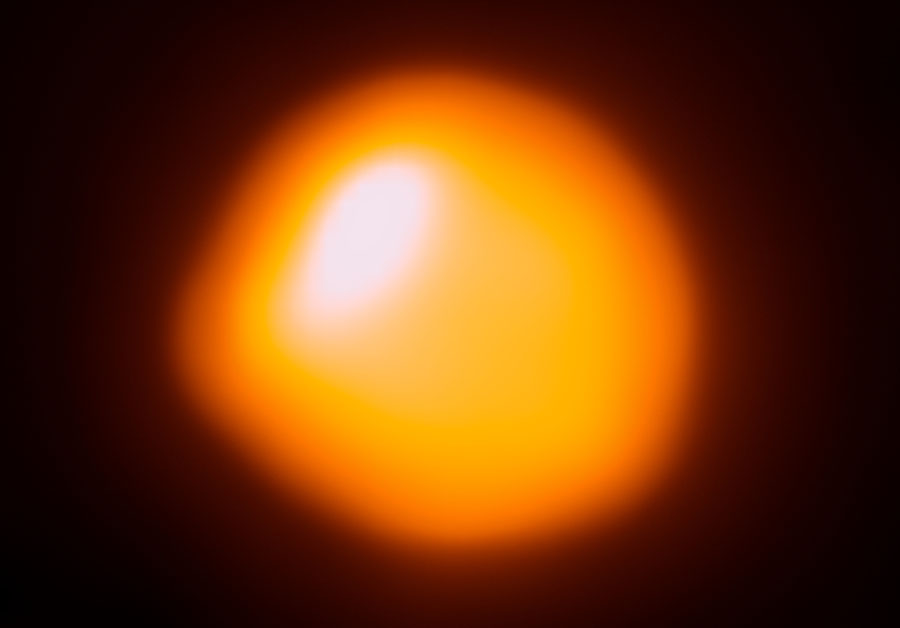ALMA (ESO / NAOJ / NRAO) / E. O’Gorman / P. Kervella
Indeed it is. But unlike the Great Dimming of 2019–20 its waning so far has been modest. Betelgeuse, located in Orion’s right shoulder, ordinarily shines at magnitude +0.4, a close match to neighboring Procyon in Canis Minor. But since late January it’s lost some of its luster — at least a third of a magnitude’s worth. That may not sound like much especially given the star’s variable nature, but the red supergiant star is currently the faintest it’s been in the past two years. Could it be at the threshold of another major dimming?

Bob King
Lest you think you can’t detect the fading with your eyes, go out the next clear night and compare Betelgeuse to Aldebaran (magnitude +0.9) and Procyon (+0.4). During the first 10 days of March, I estimated Betelgeuse’s magnitude on several occasions at either +0.8 or +0.7 — very similar to Aldebaran and clearly dimmer than Procyon. Other observers have made comparable estimates, while V magnitudes obtained instrumentally with a filter that approximates the human-eye response concur with the visual estimates.

Courtesy of the AAVSO
Use the supplied chart (above), courtesy of the American Association of Variable Star Observers (AAVSO), to gauge its brightness yourself. When making an estimate take quick looks. Shift back and forth between Aldebaran and Betelgeuse several times and then do the same with Procyon to settle on a final magnitude. If Betelgeuse’s brightness appears halfway between the two then its magnitude is about +0.6. If closer to Aldebaran it might be +0.8, and so on. To compare your results with others or simply to monitor Betelgeuse’s changes, go to the AAVSO site, scroll up and enter Betelgeuse in the Pick a Star box, then click Check recent observations.
Jing-Ze Ma
Astronomers and variable star observers have long known that Betelgeuse’s light varies with a primary period of 400 days. But since the tumult of 2019–2020 even that pattern seems to have disappeared. To our best knowledge, based on observations using the Hubble Space Telescope and others, Betelgeuse burped up a huge gas bubble that blasted more than 400 billion tons of material into space. The debris later condensed as dust that shrouded part of the star before dissipating. Astronomers detected silicon monoxide in the expanding cloud, a compound commonly found in large stars that can act as a seed to form dust grains. For comparison, the Sun loses only around a billion tons of mass during a coronal mass ejection or CME.

Courtesy of the AAVSO
Witnessing stellar evolution from your backyard is a thrill, so I hope you’ll cast a glance at Betelgeuse every clear night you can. It remains accessible for Northern Hemisphere skywatchers through mid-April and for Southern Hemisphere viewers through mid-May. What does this pivotal star have up its sleeve, I wonder?
Eclipse for insomniacs

Bob King
Eclipses come in pairs two weeks apart — one at new Moon and the other at full. April’s total solar eclipse has received much deserved press but let’s take a quick look at the less publicized penumbral lunar eclipse that will precede it. On the night of March 24–25 the full Moon will cross through Earth’s outer shadow, the penumbra. This might be worth ignoring if it weren’t for the fact that the Moon moves so deeply into the penumbra it should be baldly obvious to the naked eye.

Sky & Telescope / Leah Tiscione
Greatest eclipse occurs at 3:13 a.m. Eastern Daylight Time on March 25th when only a sliver of the Moon’s north polar region will poke beyond the shadow’s edge. Shading should be obvious across the southern half of the lunar disk. This is a late-night/early-morning event for most of North America and much of South America. Set the alarm for mid-eclipse when the shadow will be unmistakable. I eagerly look forward to this visual appetizer that will presage April’s sure-to-be-sensational syzygy.
Others willing to invest more time will catch the first whiff of shading starting about 40 minutes after the Moon first enters the penumbra and up to 40 minutes after maximum eclipse. Here are the best times to watch — centered on mid-eclipse — for a selection of time zones:
- 3:30 a.m. – 5 a.m. ADT
- 2:30 a.m. – 4 a.m. EDT
- 1:30 a.m. – 3 a.m. CDT
- 12:30 a.m. – 2 a.m. MDT
- 11:30 p.m. – 1 a.m. PDT
- 10:30 p.m. – midnight AKDT
- 9:30 p.m. – 11 p.m. HST
May your nights be stellar!


